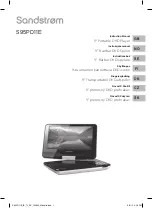
117
8
89
63
17
•
8
89
631
8
•
8
89
63
19
EN
ADDITIONAL INFORMATION FOR TABLE 1
1)
The specified nominal voltage may exhibit values in
the range of the permitted deviation for the power dis-
tribution grid.
2)
The (nominal) operating power output
(COP) is a defi-
nition in ISO 8528-1 for the total power output that the
generator is able to provide continuously, whilst provi-
ding a constant electrical load under operating conditions
and use of the generator as specified by the manufacturer
(including adherence to the maintenance plan and proce-
dures). The total electrical power output of the generator
is understood to be the total drawn power input of all
the electrical devices connected to the generator at the
given voltage, i.e. either only for 230 V or only for 400 V.
The specified max. power output serves for very short
coverage of a higher current draw by a connected electri-
cal device above the value of the continuous (long-term)
operating power output COP (see above), e.g. during the
ramp up of an electric motor of a connected device. Thus,
the generator can only be continuously loaded at the
value of the operating (nominal) power output COP.
When the generator is loaded above its max. power out-
put, the circuit breaker may not necessarily be triggered,
but rather the engine may be throttled. The power out-
put of the generator is given by the rating of the alterna-
tor and not by the shut-off current of the circuit breaker.
3)
Power characteristic class G2 (ISO 8528-1)
: the cha-
racteristic of the output voltage of the generator is very
similar to the characteristics of voltage in the commer-
cial power distribution grid for the supply of electrical
power. If changes in load occur, then acceptable short-
-term voltage and frequency deviations may occur.
Quality class A (ISO 8528-8)
: At a different operating
temperature or pressure than corresponding to the
standard comparative conditions (see table 1), the
nominal power output is not less than 95 % of the ini-
tial value specified during standard comparative condi-
tions (calculation according to ISO 3046-1).
4)
The oil volume and the weight of the generator may
differ to the specified value due to possible changes in
the capacity of the oil pan and the weight of the engi-
ne casting during production.. Pour an amount of oil
into the tank such that its level is at the level marked
on the pictogram.
5)
In the event that there is an insufficient
amount of oil in the oil pan of the engine,
the oil sensor will prevent the engine from
starting as protection against damage.
6)
AVR: The electronic input voltage regulation system
AVR limits voltage fluctuations
, which could result in
damage to the connected electrical devices. Conditions
for powering sensitive electrical devices (computers, TVs,
office equipment, etc.) and other conditions for the con-
nection of electrical devices are provided in chapter VI.
Connecting electrical devices.
7)
Standard comparative conditions
: The ambient condi-
tions of the environment according to ISO 8528-1 for the
specified nominal parameters of the generator (nominal
power output COP, fuel consumption, quality class).
III. Parts and
control elements
Fig. 1, position-description
1) Hose connector nozzle
for sliding on the gas
supply hose
2) Power switch
3),4) Indicators "oil alert"
and "power on"
Indicator "oil alert"-
signals insufficient oil
Indicator "power on"
- signals the operation of
the generator
5) Circuit breaker for 230
V power sockets
6) Circuit breaker for 12 V
power socket
7) 12 V socket for charging
12 V car batteries
8) Grounding terminal
9) 230 V power sockets
10) Motor hours counter
from the first start-up
(total motor hours),
from the last start-up,
indicator of output
voltage and frequency.
Fig. 2, position-description
1) Hose connector nozzle
for sliding on the gas
supply hose
2) Power switch
3) Motor hours counter
from the first start-up
(total motor hours),
from the last start-up,
indicator of output
voltage and frequency
4) Circuit breaker for 230 V
/ 400 V power sockets
5) 400 V power socket
6) Grounding terminal
7) 230 V power sockets
Fig. 3, position-description
1) Start-up battery
mounting bracket
(not on model 8896317)
2) Battery connectors
with connection cables
3) El. start-up battery
4) Oil (crankcase) tank oil
refill cap
5) Serial number containing
the year and month of
the generator's
manufacture and serial
production number.
6) Oil drain bolt for removing
oil from the tank
7) Wheels (not included
on model 8896317)
8) Pictogram
with the required
oil level in the crankcase
9) Oil sensor
Fig. 4, position-description
1) Gas supply valve
2) Pull cord of manual starter
3) Petrol supply valve
4) Air filter cover
5) Air filter cover clips
6) Choke control lever
Fig. 5, position-description
1) Mixer toggle switch for
LPG/CNG
2) Mixer
3) Spark plug connector
















































